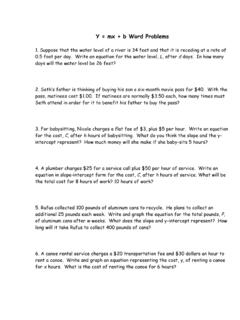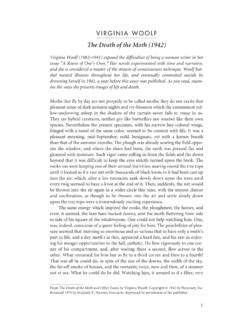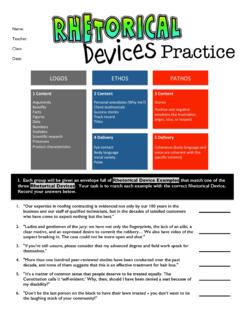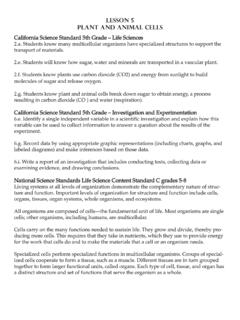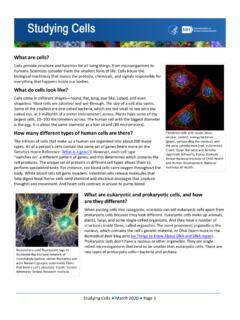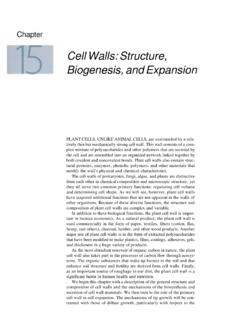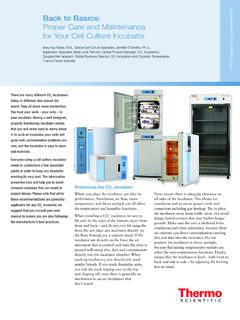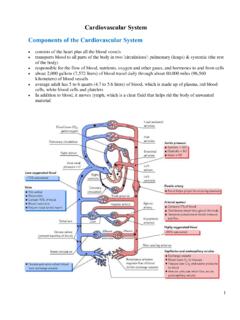Transcription of Cell Division - Mitosis & Meiosis Lecture PowerPoint
1 Cell Division Mitosis & Meiosis From the Virtual Cell Biology Classroom on Image: Cell Division , Wikipedia Eukaryotic Cell Cycle Cell grows. DNA is replicated. - Mitotic cell Division produces daughter cell identical to the parent. The timing of replication and cell Division is highly regulated. Image: Cell cycle by Richard Wheeler From the Virtual Cell Biology Classroom on Like prokaryotic cell cycle, in Eukaryotic Cell Cycle 2 major phases: Interphase (3 stages) DNA uncondensed Mitosis (4 stages + cytokinesis) - Nuclear Division & Division of cytoplasm DNA condensed Image: Cell cycle by Richard Wheeler From the Virtual Cell Biology Classroom on Interphase Non-dividing state With 3 sub-stages.
2 Gap 1 cell grows in size organelles replicated Synthesis replication of DNA synthesis of proteins associated with DNA Gap 2 synthesis of proteins associated with Mitosis Image: Cell cycle by Richard Wheeler; Interphase in Onion Cell Drawing & Photo, Source Unknown From the Virtual Cell Biology Classroom on Division of somatic cells (non-reproductive cells ) in eukaryotic organisms. A single cell divides into two identical daughter cells . Daughter cells have same # of chromosomes as does parent cell. Mitosis Packing for the When cell is not DNA molecules in extended, uncondensed form = chromatin Cell can only replicate and transcribe DNA when in extended state.
3 When cell is preparing for DNA molecules condense to form chromosomes prior to Division . each chromosome is a single molecule of DNA easier to sort and organize the replicated DNA into daughter cells From the Virtual Cell Biology Classroom on Mitosis 4 sub-phases: 1st Prophase 2nd Metaphase 3rd Anaphase 4th Telophase followed by Cytokinesis From the Virtual Cell Biology Classroom on Image: Mitosis diagram, Marek Kultys 1. Prophase Images: Prophase drawing, Henry Gray's Anatomy of the Human Body; Prophase Onion Cell Drawing & Photo, Source Unknown, Fluoresced cell, National Institutes of Health 3 Major Events - chromosomes condense - spindle fibers form (spindle fibers are specialized microtubules radiating out from centrioles) - chromosomes are captured by spindle From the Virtual Cell Biology Classroom on Fluoresced eukaryotic cell.
4 Chromosomes in blue. Mitotic spindle apparatus in green. chromatin nucleolus nucleus centrioles condensing chromosomes Prophase chromosomes align along equator of the cell, with one kinetochore facing each pole centrioles spindle fibers chromosomes 2. Metaphase Images: Metaphase drawing, Henry Gray's Anatomy of the Human Body; Metaphase Onion Cell Drawing & Photo, Source Unknown Kinetocores not pictured in this illustration. 3. Anaphase sister chromatids separate spindle fibers attached to kinetochores shorten and pull chromatids towards the poles. free spindle fibers lengthen and push poles of cell apart Images: Anaphase drawing, Henry Gray's Anatomy of the Human Body; Anaphase Onion Cell Drawing & Photo, Source Unknown From the Virtual Cell Biology Classroom on 4.
5 Telophase spindle fibers disintegrate nuclear envelopes form around both groups of chromosomes chromosomes revert to their extended state cytokinesis occurs, enclosing each daughter nucleus into a separate cell Images: Telophase drawing, Henry Gray's Anatomy of the Human Body; Telophase Onion Cell Drawing & Photo, Source Unknown From the Virtual Cell Biology Classroom on Cytokinesis Plant vs. Animal Cell Plant cells undergo cytokinesis by forming a cell plate between the two daughter nuclei. Animal cells undergo cytokinesis through the formation of a cleavage furrow. A ring of microtubules contract, pinching the cell in half.
6 From the Virtual Cell Biology Classroom on Images: Telophase drawing, Henry Gray's Anatomy of the Human Body; Ciliate dividing, TheAlphaWolf; Telophase Onion Cell Photo, Source Unknown Stages of Mitosis Image: Onion Cell Drawing & Photo, Source Unknown REVIEW! Mitosis Animations & Cytokinesis from McGraw-Hill Interactive Animation from cells Alive 1. somatic cells 2. sex cells ( gametes, germline) SEXually reproducing eukaryotes, have 2 types of body Image: Superficial human anatomy, Mikael H ggstr m& Rainer Zenz; Sperm & egg, Wikipedia Made you look! Genetics Terminology From the Virtual Cell Biology Classroom on - A single germ cell divides into four unique daughter cells .
7 - Daughter cells have half the # of chromosomes as parent cell, so they considered haploid. Image: Overview of Meiosis , National Institutes of Health What is cell Division of gametes called? Meiosis From the Virtual Cell Biology Classroom on Diploid organisms receive one of each type of chromosome from female parent (maternal chromosomes) and one of each type of chromosome from male parent (paternal chromosomes) Refers to the number of sets of chromosomes in cells . Haploid one copy of each chromosome designated as n , the number of chromosomes in one set - gametes Diploid two sets of chromosomes - two of each chromosome designated as 2n - somatic cells Genetics Terminology: Ploidy From the Virtual Cell Biology Classroom on Genetics Terminology: Homologues Chromosomes exist in homologous pairs in diploid (2n) cells .
8 Exception: Sex chromosomes (X, Y). Other chromosomes, known as autosomes, they have homologues. From the Virtual Cell Biology Classroom on Karyotype Q: Which, of the top two karyotypes is replicated? Q: How many homologous pair in each karyotype? Q: How is the bottom karyotype different from the top two? Image: Karyotype, National Human Genome Research Institute From the Virtual Cell Biology Classroom on Sexual Reproduction Fusion of two gametes to produce a single zygote. Introduces greater genetic variation, allows genetic recombination. With exception of self-fertilizing organisms, zygote has gametes from two different parents.
9 Peter + Lois = Stewie Images: Peter, Lois & Stewie, The Family Guy From the Virtual Cell Biology Classroom on Sexual reproduction in humans .. At fertilization, 23 chromosomes are donated by each parent. (total = 46 or 23 pairs). Gametes (sperm/ova): Contain 22 autosomes and 1 sex chromosome. Are haploid (haploid number n = 23 in humans). Fertilization results in diploid zygote. Diploid cell; 2n = 46. (n = 23 in humans) Q: Most cells in the body are produced through what type of cell Division ? Only gametes are produced through Meiosis . Image: Superficial human anatomy, Mikael H ggstr m& Rainer Zenz; Sperm & egg, Wikipedia From the Virtual Cell Biology Classroom on Meiosis - Sex Cell (Gamete) Formation In Meiosis , there are 2 divisions of the nucleus: Meiosis I & Meiosis II Image: Overview of Meiosis , National Institutes of Health From the Virtual Cell Biology Classroom on Image: Meiosis diagram, Marek Kultys From the Virtual Cell Biology Classroom on REVIEW!
10 Meiosis Animations Meiosis Works from McGraw-Hill Interactive Animation from cells Alive Meiosis & Sexual Reproduction Life Cycle Image: Animal Life Cycle, Dr. T s Bio 328 Genetics Mitosis * * * From the Virtual Cell Biology Classroom on Genetic Variation in Diploid Organisms Fusion of sperm and egg results in unique offspring. But not only because the young are a product of two individuals with different genetic makeup. Meiosis shuffles the genes so that the an individual s gametes are genetically different from one another. From the Virtual Cell Biology Classroom on Image: Meiosis diagram, Marek Kultys How is this shuffling accomplished?






